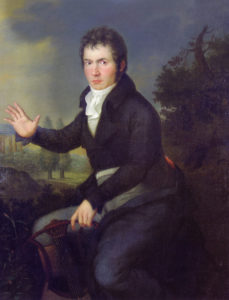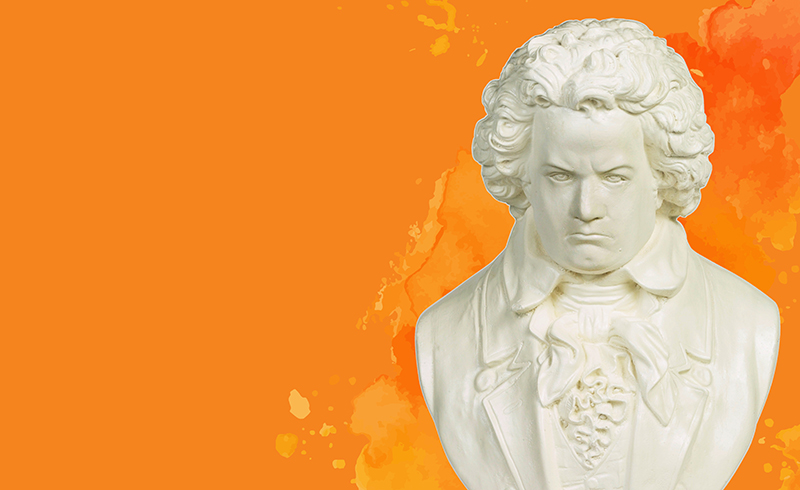On October 25, 26, and 27, world-renowned conductor Marek Janowski leads Wagner + Beethoven 2, a program of thrilling orchestral masterpieces by two of history’s most revolutionary composers. In this post, discover how Beethoven composed one of his most up-beat works in the midst of personal crisis. Want to learn more? Check out our podcast on this symphony.

Beginning perhaps as early as 1796, Beethoven began to notice what biographer Maynard Solomon describes as “intermittent symptoms of tinnitus, such as humming, ringing, buzzing, and other discordant sounds in the ears,” as well as “partial loss of his ability to distinguish high frequencies.” Furthermore, “sudden loud noises caused discomfort and even pain.” Beethoven began to seek medical advice in 1802. One doctor prescribed applying almond oil in his ears; another cold water baths; others pills, potions and other infusions, but his hearing only worsened. That summer, Beethoven rested his ears at Heiligenstadt, a small town just outside of Vienna. There, he completed his Second Symphony.
Given the circumstances, one might expect dark and foreboding music, but as George Grove noted, “On the contrary, there is not a single desponding bar in the whole work.” The symphony’s energy, comedy, and even swagger can be heard as a kind of bravado—Beethoven showing off his musical imagination, perhaps even trying to hide his inner turmoil. At the same time, the music bristles with an intensity that is perhaps never fully resolved.
The Music
The symphony begins with a slow introduction that was unusually weighty and complex for its time:
https://www.youtube.com/watch?v=3MGXpakCu9I&t=48s
The harmonies wander from a secure opening in D major to a powerful statement in D minor. The sound of major juxtaposed with minor returns throughout the movement, giving it a wild, unstable energy. Some commentators have even detected a military character in the movement; the French composer Hector Berlioz, for instance, remarked on its “warlike sallies.” Whether Beethoven intended such an interpretation is a matter of speculation, but a military topos may reflect the contemporary political situation as Europe became embroiled in the Napoleonic age.
The faster main body of the movement begins with an energetic main theme for low strings that imitates the rhythm of a drum roll. A tumultuous transitional passage then leads to a second theme in the clarinets and bassoons that playfully contrasts soft and loud dynamics. Music full of explosive accents and surprises leads back to a repeat of the two main themes. After the repeat, an eventful developmental section fragments and transforms the movement’s themes as the harmonies become increasingly unstable, ultimately arriving at a reprise of the movement’s main themes. In the coda, the music rises to an exultant climax in the trumpets.
After the excitement of the first movement, the Larghetto seems to deal more with matters of the heart. Strings and woodwinds politely take turns with the phrases of the disarming opening melody, but the following operatic duet between clarinets and violins leads to a tense moment. A yearning second theme appears soon after in the violins, and a second transition leads to a simple, songlike tune introduced by the second violins and cellos. A fully worked out development ensues, building a surprising emotional intensity. After a reprise of the three main themes, the movement concludes with a final reminiscence of the main theme.
The second half of the symphony displays Beethoven’s rather broad sense of humor. In the third movement, Beethoven casts tradition aside by writing a Scherzo instead of a minuet. The word “scherzo” is Italian for “joke,” and in contrast with typically stately minuets, scherzos tend to be full of mischievous musical jokes and surprises. With its unexpected accents and sudden harmonic and dynamic shifts, this movement is no exception. A complimentary (rather than contrasting) middle section begins with a tune for oboes and bassoons.
In the finale, every trace of eighteenth century decorum is discarded as the music hurtles at breakneck speed, full of squeaks and guffaws. The woodwinds attempt a more graceful mien with a contrasting second theme, but they are soon overrun. The music seems to return to the beginning of the movement for a repeat of the main themes, but instead veers off course into a topsy-turvy development. After a reprise of the main themes, the symphony ends with uproarious laughter. —Calvin Dotsey
Want to learn more? Check out our podcast on this symphony.
Don’t miss Beethoven’s Symphony No. 2 October 25, 26, and 27! Learn more and get tickets.



